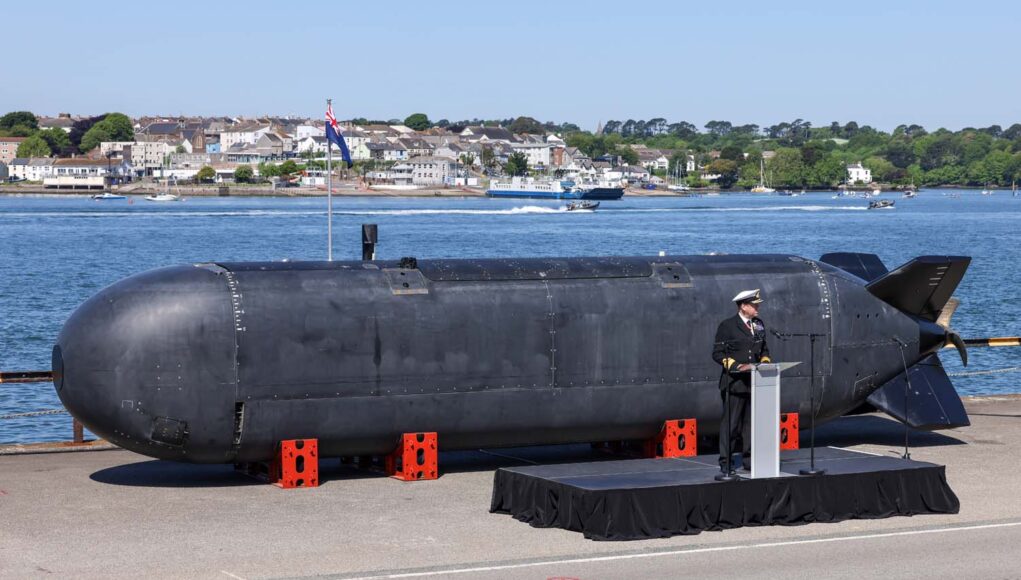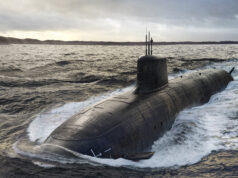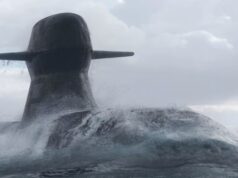According to a recent Royal Navy news update, the Royal Navy has unveiled its first uncrewed submarine, named XV Excalibur, at HMNB Devonport. The 12-metre vessel, displacing 19 tonnes and measuring two metres across, marks a significant milestone in the UK’s underwater warfare capabilities.
The Excalibur is the culmination of the three-year-long Project Cetus, which aimed to explore advanced uncrewed underwater systems. It is the largest uncrewed underwater vessel trialled by the Royal Navy to date and was unveiled during a formal naming ceremony attended by 200 guests, including Rear Admiral James Parkin, Navy Director Develop, and representatives from AUKUS nations.
The Excalibur will undergo extensive sea trials over the next two years, gathering critical data and helping develop the Navy’s operational understanding of large uncrewed underwater systems. This testing phase aims to enhance the Royal Navy’s ability to integrate advanced technologies into mixed fleets of crewed and uncrewed vessels.
The craft was built by MSubs, a Plymouth-based company specialising in automated submersibles. Commodore Marcus Rose, deputy director Underwater Battlespace Capability, highlighted the importance of the project:
“The naming of Excalibur is a significant milestone for the Royal Navy and the upcoming sea trials will allow us to rapidly develop our understanding of operating uncrewed vessels of this size underwater,” said Commodore Rose.
Rear Admiral Parkin also stressed the importance of practical testing, stating:
“In our journey towards autonomy and mass, it is vital we learn by doing, and Excalibur will be our mechanism for understanding the complexity and challenges of operating a future team of crewed and uncrewed vessel and systems underwater.”
Officially classified as an Extra-Large Uncrewed Underwater Vessel (XLUUV), Excalibur will join the Fleet Experimentation Squadron under the Disruptive Capabilities and Technologies Office. The squadron already includes the surface ship XV Patrick Blackett, with Excalibur acting as a testbed for cutting-edge maritime technology.
The vessel will primarily focus on Intelligence Surveillance and Reconnaissance (ISR) and stealth operations, leveraging its capacity to carry bespoke payloads. As a demonstrator platform, it will not carry out operational duties but will instead shape the future of the Royal Navy’s mixed fleet approach.
Excalibur’s name draws on the legendary sword of King Arthur, reflecting the vessel’s pioneering role in the Navy’s transition to advanced autonomous warfare. The name also pays homage to a high-speed experimental submarine tested by the Navy in the 1950s and 60s.
Following its delivery earlier this year, Excalibur has already completed Harbour and Sea Acceptance Trials (HATs and SATs) at Devonport Naval Base. Rear Admiral Parkin summarised the project’s ambition:
“This is an exciting day for the Royal Navy, the UK Armed Forces, and my team in particular as today marks the moment at which we take ownership of this superb vessel for the first time.”














and replaces entire surface fleet with one robot sub.
Surely HMXV Excalibur?
This remote sub could be the most significant RN development in a hundred years. We know just how brilliant the WW2 Mini Subs were and size does matter. The scope for these subs is huge a small but well-distributed fleet across the World would be most effective.
Good Day! Develop and expand this Technology to our advantage! One should also develop an armes variant to attack at will.
An armed variant
I think that’s the aim, at least for some variants.
What’s it going to be attacking?
It might just be able to carry Spearfish, but not alongside a sonar array capable of exploiting it.
You might be able to use it as a moving mine, but there isn’t really an effector that would allow that. Some sort of ultra short range torpedo, or an “upwards depth charge”.
I think we have to wait until the larger Moray concept, or something of a similar size, until offensive action becomes possible.
I was wondering the same. I suppose they will protect our undersea cables and pipelines but how long could they patrol as they would surely need quite a lot of power and only will carry so many batteries.
The cables and pipelines role would be a good use of this asset.
I wonder if it would be possible for surface warships to carry something like one of these routinely, as a countermeasure ready to be deployed at the first hint that there may be an unfriendly sub around? At the very least it might distract the enemy.
Sounds like a good idea. I’d imagine they’ll come loaded in a PODS format with a controller. As long as we can get this to fit into an ISO shipping container then no reason a type 26 mission bay or the back of a Bay class couldn’t deploy them. I’d have said the Albion/ Bulwark could be stripped out to act as USSV motherships and operate a fleet of these but HMG penny pinchers have removed that idea.
12 meters is 39 feet 4 inch approx, so would be a pretty tight fit into a 40 ft ISO. Would possibly fit in an “open frame” ISO, but not my area of expertise.
I thought we already had a UUV called Manta.
Is this just bigger?
Manta is the US one.. ours looks meaner and more proper.. the U.S. one looks like a prop from stingray…
Manta Ray is the US one. Just Manta is a white and orange thing our navy were mucking about with before. I assume it still exists but haven’t seen it mentioned for a while.
Me neither.
Assume another round of never ending trials to inform more decisions….to go trial some more.
Manta was delivered by MSubs to the RN 5 years ago and undoubtedly a lot of the lessons from trialling that have been incorporated into this slightly larger XLUUV. (While MSubs have a background in small submersible craft, the autonomous operation capability was new with Manta.)
Thanks.
Right get it in the water and tested pronto. If it’s any good we need 10-15 of these operational asap around the UK home waters, armed and ready to help protect key sub sea infrastructure and prosecute pesky Russian subs loitering too close to our shores.
Armed version using stingray lightweight torpedoes would be good.
I want to congratulate Msubs, the Royal Navy and anyone associated with such an achievement. Only the US has shown such vessels to my memory. This sub could allow the Royal Navy to deploy dozens of such ships in a conflict.
A good news story!
The RAN down here in Aus has their “Ghost Shark” large uuv coming along too. Not sure how same same it is with the Excalibur. OZ will likely give a detailed reply on that.
The RANs Ghost Shark was developed by Anduril who were contracted in May 2022. It was unveiled and designated Ghost Shark in December 2022. The Alpha prototype version delivered in April 2024 is 12 metres long (shorter than Excalibur) but has a similar square cross section of 3 metres (deeper than Excalibur) suggesting a similar internal volume. However it is scalable and the final production variant may be longer, the first of which should be delivered in late 2025.
At the April 2024 announcement sea trials were claimed to have been underway “for some time” and are ongoing including a deployment to Hawaii by RAAF C17 for sea trials with the USN demonstrating the platforms global deployability. It is capable of operating at depths of up to 6,000 metres and undertaking ISR and strike missions of up to 10 days (again final production variant may be larger with bigger payload and/or longer endurance).
The Ghost Shark can carry and launch a number of Anduril’s innovative Copperhead system mini USVs which can be configured with different payloads including a warhead (essential becoming a torpedo on the move or a mine if stationery) or deploy a sonar array (unwinds something like a towed array sonar but stationary on the seabed at strategic choke points). No word on if/when the RAN intends to acquire these systems for its Ghost Shark fleet but seems at least the Ghost Shark has been used as a test platform for Copperhead.
Good to see the announcement of Excalibur for the RN. To quote Bruce Willis “Welcome to the party pal”.
Nice and extensice reply OZ! Wonder if there’d be any cross-sharing of tech through AUKUS with this?
China have shown off several, as have Australia and South Korea.
Yes. Arundil’s Ghost Shark is just one of three large UUVs under development by the RAN each with slightly different capabilities.
Ghost Shark is modular and has a large and versatile payload bay and able to operate a depths far greater than any crewed submarine.
Also in development in Australia for the RAN is C2 Robotics Speartooth (modular payload and range up to 2,000 kms). As well as ISR payloads it’s more streamlined shape and long range coupled with a warhead has potential as the underwater equivalent of a cruise missile.
While the Sea Wolf UUV being developed by TAS and Cellula Robotics is the newest/least developed but potentially longest ranging up to 5,000 kilometers.
Assuming all three systems are fielded in strategically relevant numbers the RAN could have hundreds of a versatile mix of UUVs for the price of a single crewed submarine.
Must admit I was mistaking this effort for Herne which Bae was testing late in 2024 and is also 12 metres long. Different projects it seems though not dissimilar eventual aims perhaps. It seems, as someone asked, that Manta is still present on MSubs website.
It’s just a cover story, hide the fact it’s a really big bomb! 🤣
From a layman’s perspective it looks like a very large torpedo remote controlled or self directed it would carry a most impressive payload even a nuclear one if necessary.